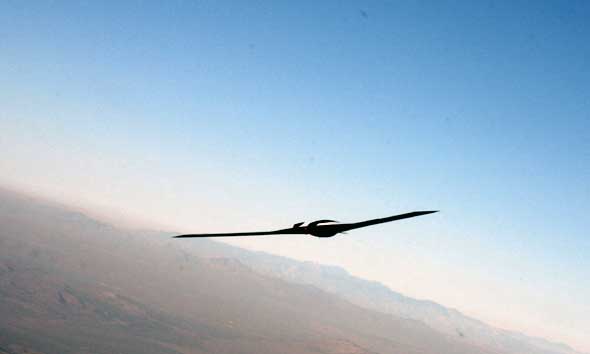
The Lockheed Martin Skunk Works revealed on 19 July that it has secretly built and flown a large, high-altitude unmanned aerial vehicle (UAV) that has been designed to test a range of new technologies critical to what the company foresees as a ‘third-generation’ of unmanned platforms that will emerge in the US in the next decade.
Nicknamed Polecat, the high-altitude flying wing demonstrator was launched in March 2003 with $27 million of internal Lockheed Martin funding and was completed 18 months later. It did not fly, however, until last year. Its key feature is an advanced laminar flow wing that confers a blend of high aerodynamic efficiency with a very low observable (VLO) radar cross-section.
Polecat technology could lead to two operational vehicles, according to Cappuccio: an intelligence, surveillance and reconnaissance (ISR) vehicle with a U-2-like (1,800 kg) sensor payload and a 24-hour endurance; or a long-range strike aircraft with a 6,800 kg payload and a 3,700 km operational radius. He added, however, that Lockheed Martin is still pushing the idea of a supersonic UCAS for the LRS mission, citing studies that show that it would be seven times more survivable than a subsonic UCAS and five times better than the FB-22 bomber derivative of the F-22 fighter.
Amazing stuff. Even more amazing, of course, is that they didn’t dip directly into the public till for the development work.















Wow, how cool would it be to actually work for the Skunk-Works! And how cool would it be to tell people you work there? And how cool would it be to actually kill the people you tell because they’re not really suppose to know?
i gotta get me one of those
HA..I think they had to announce it. It was shown on that Discovery Channel special on Asteroid impacts. It’s used to collect space dust. When I saw it (this was long before July 19) I was a little taken aback since I’d never seen this thing before. It’s cool looking.
27 million is almost the daily take from the coffee machine where I work.
NOW.
its interesting that Long ago, we thought…
that High altitude ment they couldnt detect it, but they did, and shot 1 down.
do they understand the basic principle of a Circle.
If you fly close to the center you can travel Very fast.
The farther out you go on the circle, the FASTER you must go to cover the same amount you COULD have done at CLOSER and quicker.
DONT think that if its 10+ miles up that SOMETHING cant hit it.
its called predetermination. You KNOW its going this fast, you know its going THAT WAY, and in 10 minutes it will be about THIS far away. Send up about 3-4 heat seekers ABOVE it, and have them track it from the front…at 10+ miles, HEAT is very easy to find, as there ISNT much. and goinc Sonic, just makes you a better target.
The reason this particular aircraft will never be detected by the nasties is that it will be blessed by one of those shakey things wielded by a priest of an obscure religious order who has been nurtured by the CIA as part of it’s alternative tactics program.
6 You KNOW its going this fast, you know its going THAT WAY, and in 10 minutes it will be about THIS far away.
And you know those things because you have used search radar to detect the aircraft, and said aircraft will have ESM to detect the radar being pointed toward it.
If the plane makes any avoidance maneuvers, the small control surfaces of the missle can not compete with the broad wing-span of the plane – especially in such thin air.
Powers got spanked because he didn’t think any missiles could reach him.
As you state – we know better now…
……
Fun to read the CIA’s “cleaned” version of the report from the board which verified Power’s testimony, released due to a Freedom of Information act request.
http://tinyurl.com/xbya
The really interesting part is how it was manufactured. I’m fascinated by 3-D printing technology, and that’s how this fancy plane was made for a low price. I didn’t notice any mention of 3-D printing technology in PC Magazine’s new issue on the future of tech, but this should be #1 with a bullet. Under the radar maybe, but here’s a little more:
[editor: pls use tinyurl]
If we’re watching the same Discovery Channel, John — though similar, the aircraft used for chasing meteroid dust on the special must be a different craft.
Along with being piloted — it has a fuselage and tail and the Polecat is a flying wing. Here’s an enormous photo of it.
i work at skunkworks and yes its fun.